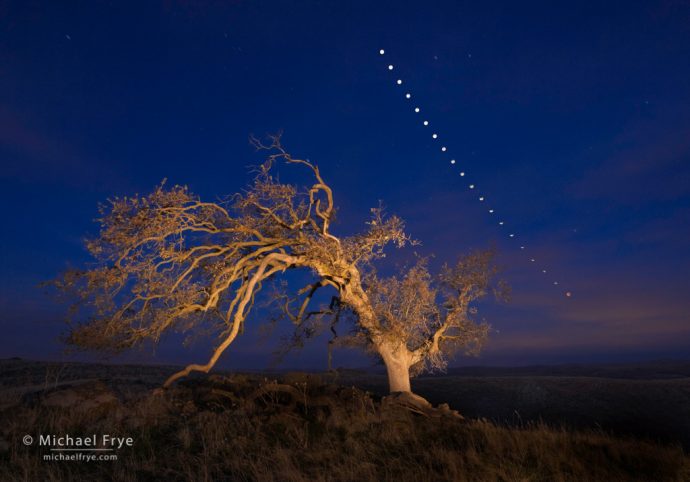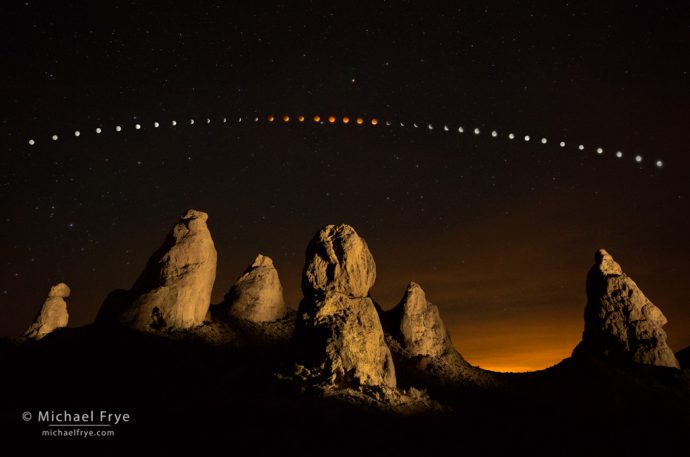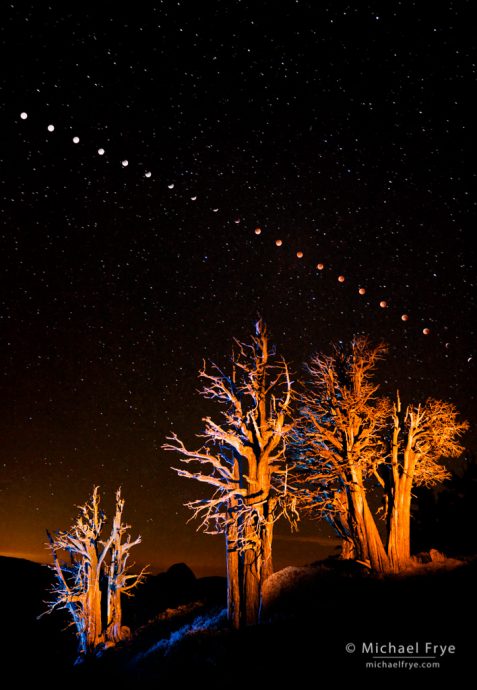In case you haven’t heard, there’s a total lunar eclipse coming up on January 31st. The total eclipse will be visible in central and western North America, Australia, and much of Asia. It will also be a “blue moon,” (the second full moon of the month), and a “supermoon,” (with the moon closer to the earth than normal, so it will look slightly larger). This page shows where the eclipse will be visible, as well as the timing of the event.
In North America the eclipse will occur as the moon is setting in the west just before sunrise. The further west you go, the higher the moon will be during totality, and the longer the eclipse sequence you can see. People in the mountain states should be able to see the entire one hour and sixteen minutes of totality, while those of you in the northwest could see (with clear skies) all of totality plus all of the partial eclipse phase afterwards. Unfortunately, the total eclipse will not be visible on the east coast of the U.S. and Canada.
Since the eclipsed moon will be low in the sky to the west in North America, there should be some great opportunities to juxtapose the moon with natural or manmade features. I’m sure we’ll see photos of the eclipsed moon next to the Space Needle if there are clear skies in Seattle. And the same goes for the Golden Gate Bridge. But any spot with an interesting view to the west could work, so there are tons of possibilities.
Equipment for Photographing a Lunar Eclipse
Moon Position and Timing
When the partial eclipse begins the moon will become a smaller and smaller crescent as the earth’s shadow seems to take a bite out of the moon. During the total eclipse the moon will look much dimmer, and turn orange or even red-orange in color. The sky will be full of stars, as if on a moonless night. Just after the total eclipse the moon will return to a slender crescent and then get larger and larger, until the eclipse ends and the moon becomes completely full again. (You won’t be able to see this last partial phase in much of North America during the January 31st eclipse.)
With most nighttime images you want to get away from city lights and light pollution. You don’t necessarily need dark skies for a lunar eclipse, as the moon should be clearly visible even in urban areas (and even during the maximum eclipse). Having said that, the moon will stand out more clearly with darker skies away from city lights.
To calculate the moon’s position accurately – if you want to line it up with a building or mountain, for example – you’ll need an app like The Photographer’s Ephemeris, The Photographer’s Ephemeris 3D, or PhotoPills. And you’ll need to know the timing of the eclipse, so here are the important moments:
Partial eclipse begins: 11:48 UT, 3:48 PST
Total eclipse begins:12:52 UT, 4:52 PST
Maximum eclipse: 13:30 UT, 5:30 PST
Total eclipse ends: 14:08 UT, 6:08 PST
Partial eclipse ends: 15:11 UT, 7:11 PST
Knowing the timing of the eclipse, you can use one of the aforementioned apps to figure out exactly where the moon will be from a given location at each stage of the eclipse. For example, from my house at 5:30 a.m. (the maximum eclipse), the moon will at an azimuth (compass direction) of 277 degrees, and an altitude of 18 degrees. I won’t be able to see the end of the partial eclipse from here, as according to The Photographer’s Ephemeris the moon will be at an altitude of -0.4 degrees at 7:11 a.m. – just below the horizon. (It will also be getting pretty light by then, since sunrise will be at 7:04 a.m.)
Focusing
Since most modern lenses focus past infinity, you can’t just crank the focusing ring all the way to the end and expect to get sharp photographs. The most accurate way to focus in the dark, by far, is to use live view, magnify the image to zoom in on the moon, and focus manually. Autofocusing on the moon should also work if the moon is bright enough (like before the total eclipse begins) – but be sure to then turn autofocus off so that the camera doesn’t accidentally focus on something else when you press the shutter button.
Exposure
Light meters are useless for getting good exposures of the moon, because even a one-degree spot meter can’t read just the moon, but will also include some of the surrounding black sky. So here are some suggestions based on past experience, including making the accompanying photographs. You’ll need to use manual-exposure mode, and check your camera’s highlight alert (the blinkies) to make sure you’re not overexposing the moon:
Full moon, or moon more than half visible: 1/60 sec. at f/11, 200 ISO
Half to one-quarter of the moon visible: 1/30 sec. at f/11, 200 ISO
Less than one-quarter of the moon visible: 1/15 sec. at f/11, 200 ISO
Just the edge of the moon lit: 1 sec. at f/11, 200 ISO
Fully eclipsed at the beginning and end of totality: 8 sec. at f/11, 800 ISO
Fully eclipsed, deepest totality: 8 sec. at f/11, 1600 ISO
In these examples I’ve kept the aperture constant at f/11, but if you need more depth of field you could use f/16 and either double the ISO or the length of the exposure. But you want to keep the exposures relatively short, otherwise the moon will move and blur. You can get away with eight or maybe even fifteen seconds with a wide-angle lens, but with a telephoto lens you need to use shutter speeds of four seconds or less. To find the maximum exposure time for your lens before movement appears, divide the focal length into 400. So 400 ÷ 25mm = 16 seconds, or 400 ÷ 100mm = 4 seconds. Bracketing exposures is a good idea.
Eclipse Strategies
Trying to include a foreground makes things more complicated, so the simplest way to photograph a lunar eclipse is to take a long lens and zoom in on the moon. If you photograph the eclipse from beginning to end you can even use Photoshop to assemble your images into a montage showing the whole sequence.
A more evocative approach – but a more complicated one – is to use a wide-angle lens and capture the eclipse sequence with a foreground, as I did in the accompanying images. To do this you’ll first need to figure out the exact path the moon will take so you can compose your photograph accordingly. The apps I mentioned above, PhotoPills, The Photographer’s Ephemeris, and The Photographer’s Ephemeris 3D, are invaluable for this. And you’ll want to get to your chosen spot early enough to capture the entire eclipse sequence, from full, to partially eclipsed, to fully eclipsed, and (if possible from your location) back through the partially-eclipsed stages.
Once you’ve composed, make sure your tripod is solidly planted and locked tightly. If your composition includes a foreground you’ll want to focus at the hyperfocal distance, which will be somewhere between the closest object to the camera and infinity, but closer to the foreground. (If you don’t know how to find the hyperfocal distance, just focus on the foreground.) Then use a small enough aperture to get both foreground and moon in focus. (A bright flashlight and live view are helpful for focusing on the foreground.)
Then make a series of exposures to capture the eclipse sequence. In the three photographs here the interval was ten minutes between each moon capture, but you could make it fifteen or twenty minutes if you want to space the moons farther apart. Just make sure you keep the interval the same throughout the sequence. You can use an interval timer for this, or just use a watch and trip the shutter manually (using a remote or cable release, of course). You’ll need to adjust the exposure times (and possibly the aperture or ISO as well) as the moon dims and brightens.
In the accompanying photographs I used electronic flash or a flashlight to light-paint the foreground in between making exposures of the moon. Light painting is a complex subject that I won’t get into here, and if this is the first time you’ve ever tried photographing an eclipse I’d suggest you keep it simple, and don’t try light painting. Just try to capture single images of the moon itself, or perhaps a sequence with silhouetted trees or other objects in the foreground.
You might also capture a frame to use as the base (background) layer in Photoshop. For example, in the sequences from the Trona Pinnacles (top) and Yosemite (second image), during the total eclipse I made an exposure for the stars, and used that starry sky as the background for the eclipse sequence. For the sequence with the oak tree from the Sierra foothills (below) the background is an exposure made as the sky was beginning to lighten and turn blue at dawn:

Oak tree and lunar eclipse sequence, December 10th, 2011, Mariposa County, Sierra foothills, CA, USA. This was a also a winter eclipse that occurred just before sunrise, so the moon’s path was quite similar to the path the moon will take during the upcoming eclipse on January 31st in North America. The moon’s path will curve to the right as it descends, and in most of the continent the sky will start to lighten during the total eclipse, as it did here.
Assembling a Sequence
If you get ambitious and try a sequence, the final step is to assemble the images in Photoshop. From Lightroom you can select the images and choose Photo > Edit In > Open as Layers in Photoshop, and Photoshop will stack the images into one document as separate layers. Or you can do this by hand using the Move tool to drag one image on top of another; just make sure you hold down the shift key while dragging so that the images align properly.
Drag your background layer to the bottom of the stack in the Layers Panel. Then change the blending mode of every layer except the bottom one to Lighten. This makes light areas override dark areas, so the moon from one frame will override dark sky from another frame. As you do this you’ll see all the moons magically appear and complete your sequence. If you light-painted a tree or other object, that too will appear when you change the blending mode for that layer. And if you used a telephoto lens to capture the whole eclipse sequence, you can use the Move tool to drag each layer around and arrange the moons on your canvas.
Upcoming Lunar Eclipses
Photographing a lunar eclipse takes planning, and a willingness to lose some sleep, but it can be a tremendously rewarding experience. And if your photographs don’t turn out as well as you hoped, you might get another chance soon. There will be another total lunar eclipse on July 27th this year, visible in Europe, Africa, and much of Asia. And on January 21st of 2019 a total lunar eclipse will be visible in all of the Americas, Europe, and some of Africa.
Good luck!
— Michael Frye
Related Posts: Lunar Eclipse Wednesday Morning; This Sunday’s Lunar Eclipse
Michael Frye is a professional photographer specializing in landscapes and nature. He is the author or principal photographer of The Photographer’s Guide to Yosemite, Yosemite Meditations, Yosemite Meditations for Women, Yosemite Meditations for Adventurers, and Digital Landscape Photography: In the Footsteps of Ansel Adams and the Great Masters. He has also written three eBooks: Light & Land: Landscapes in the Digital Darkroom, Exposure for Outdoor Photography, and Landscapes in Lightroom: The Essential Step-by-Step Guide. Michael has written numerous magazine articles on the art and technique of photography, and his images have been published in over thirty countries around the world. Michael has lived either in or near Yosemite National Park since 1983, currently residing just outside the park in Mariposa, California.











Again, I’d like to thank you for your succinct and helpful approach to this. I’m looking forward to attempting a sequence in Yellowstone this month. Thank you for the time spent to assemble this.
You’re welcome Randy – and thanks.
Michael,
Fabulous images and essay — thanks!
Cheers,
Alyn
Thank you Alyn!
One of the best I have read, complete and to the point, I could find all kinds of stuff that talked about before and after the eclipse, but nothing specific about the eclipse portion itself, thanks for the enlightenment.
Thanks Ryan – glad you found this helpful!
I’m a little confused regarding the time of the eclipse in California. Is it 3:48 AM i.e. the very early morning of Wednesday Jan 31st?
Yes, that’s right, the partial eclipse starts at 3:48 a.m. on the 31st in California. You’ll have to get up early. 😀
Loved the information in this! I’m in the PNW about 35 miles from the coast, and am watching the webcam at Cape Kiwanda as the moon is setting this morning. I’m praying we get enough clearing tomorrow to shoot it. I was curious as to what wide angle you used? I have a Sony 6500 with a 16-70 and a rokinon 12. Cape Kiwanda will be the backdrop, and I’m wondering if my 12 would make the moon too small?
I don’t think you can pick which lens to use until you get there and figure out the composition you want (taking into account the position of the moon). Yes, your 12mm would make the moon pretty small. That might be okay if you’re capturing a sequence, but might be too small for a single moon. The photograph at the top of this post was made with a 17mm lens on a full-frame sensor, which is similar to 12mm on your camera.
Very helpful exposure tips for the January 31 total lunar eclipse. Thank you. With my Canon 1DXII I was able to use ISO 6400 during totality to get nice sharp photos with my 100-400II at 400mm.
Happy I could help!
Hi Michael, another great educational article! Thank you very much. Appreciate the recomendations for settings. Your “rule of thumb” to divide”400″ by the focal length of the lens to get the maximum time without visible motion actually is not a universally useful number. It depends on a few things. First, the resolution of your camera sensor. Second, how large of an image you plan to create. For instance, with my 35 mP D810, the moon subtending an angle of 31 arcmin, my 200-400 f/4 at 400mm,a 1.4 Tele on the back end of this lens, and a 1 sec exposure, I calculate that I could expect to see a movement across the sensor of 8 pixels during the esposure. I measured about 60% more. I suspect the extra may have been due to relaxation movement of the camera on the tripod as I had to reposition it frequently to keep the moon in frame and with that much weight on the ball mount (RRS) Gitzo tripod, I think there may be some relaxation of the postion after tighting down – just a guess. I probably should have shot with a shorter eposure, but I was already at ISO 1000 and a combined f# of 5.6 (lens plus Tele) and didn’t want to push the ISO farther – probably should have. I can see the motion of the edge of the image even on my computer screen. And the detail at max eclipse is not great in the body of the moon. The exposure at max eclipse was on the far left of the histogram – not at black, but very close.
Good point Greg. That 400 number will not yield perfectly crisp moons, and stars will be slightly streaked. It’s a compromise, like so many things in photography. It works well enough for stars with wide-angle lenses, but I think slight movement becomes more critical with long lenses, when the moon becomes large in the frame, and lack of sharpness is more noticeable. Many people talk about the 500 rule, or the 600 rule, but using those numbers will make shutter speeds longer and create more blurring/streaking. Maybe with long telephotos we need to talk about the 200 rule.
Hello Michael,
When you shooting a series of moons, do you need to change the frame so the moon does not fall off your frame? I have never tried this and would like to learn. I have a 24-70 mm lens. Hopefully, the 24 mm is wide enough so the moon can stay in that one composition.
Thank you,
Bailing
If you plan correctly you shouldn’t need to move the camera. You have to calculate the path of the moon so that it stays within the frame during the sequence you’re planning. Apps like The Photographer’s Ephemeris and PhotoPills are invaluable for planning images like that. Of course some photographers deliberately move the camera – for example using a telephoto lens to capture images of the moon (therefore making the moon look bigger), then compositing those frames with a wide-angle view of the landscape. I don’t find those composites appealing, but to each their own.